The inhabitants of Junkville didn’t spell a cast on us, and I didn’t hear a single story about “taper le diable”. The devil may be invisible, but the chief Daniel is treating us with the greatest care and respect. Two guys on bicycles with dirty clothes are definitely welcomed differently in Africa than in Europe. But I have no means of experimenting with different skin colors for an exhaustive study …
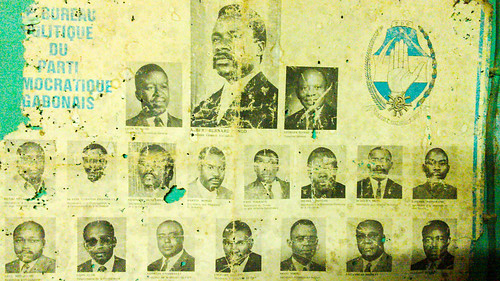
Daniel is a very kind old man and the walls of his house are decorated with funny posters. Jennifer Lopez is showing her legs between Bibie and Omar Bongo, while Jesus is watching from the other corner. Maybe the devil hit my rear tire: it is deflated when leaving Junkville. I inflate it again twice, after what it seems to hold together. I am not very confident though, and the road is not the kind of road one wants to be stranded in.

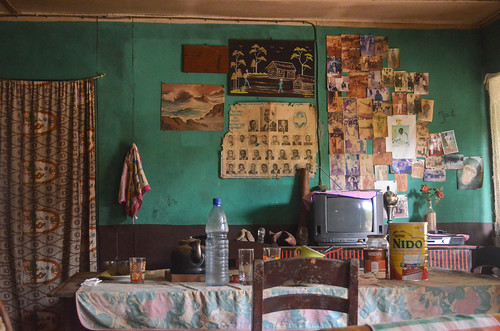
Indeed, we are about to cross a national park. La Lopé seems, at first, like any other game reserve in Africa, with elephants and wild animals. The difference is that our route is going right through it. The section of the route économique between Alembé and Lastoursville passes along the Ogooué river in the north of the park.
In South Africa, it’s forbidden to get off your car in a game reserve, and it’s even advised not to open the window more than a third. Here, nobody seems to worry about us cycling through it. I wonder if we will be stopped at the entrance and asked to ride the dangerous segment in a truck, or if we will be forced to pay for an armed escort. After all, there are panthers in there, and I won’t defend myself with a bicycle bell and a camera tripod.
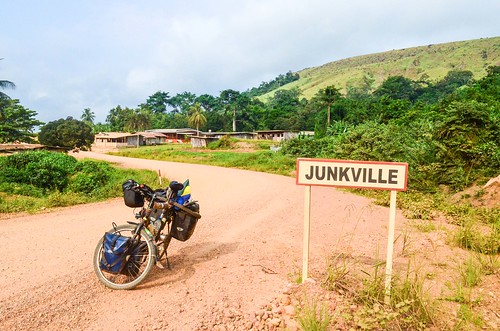
After 8 kilometers only, we make our first stop when we see mangoes. It is the season. In Senegal, it was in May, and now in Gabon, it is in December. But they are far from being as big and as delicious as in Casamance.
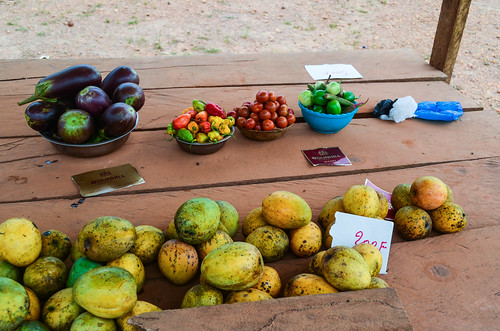
I talk in Spanish with an Equato living here. Despite the vastness of the Hispanic world, he says that Equatorial Guinea is the only country in the world, besides Spain, that speaks proper Castellano. He adds the he can easily get a visa for Spain, and that his son is studying there. However, the visa thing is far from being reciprocal … Equatorial Guinea is almost hermetic to foreigners, and for sure not tourist-friendly. He confirms it, saying there is a “law preventing people to take pictures” there.

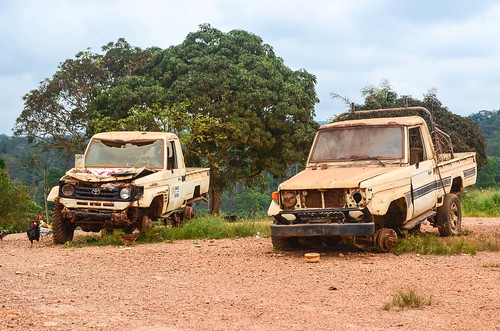

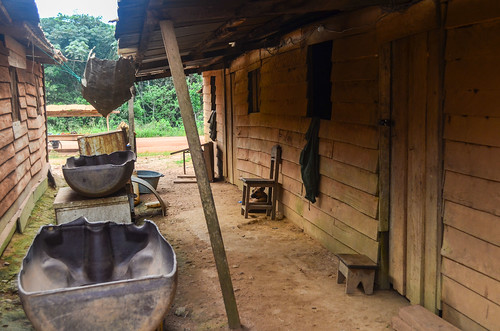
We keep cycling up and down. I thought it would be rather flat, following the river, but the road is not optimized at all. The surface is however quite good. Even if it is not paved, the grading machines are doing a good job. Apparently, the Chinese are building it from the other end.


Since we left Junkville, there has been no phone coverage in the jungle. It’s not surprising. What is funnier is that someone took the care to mark when it is possible to catch the signal.

We need to cycle 50 kilometers until the pont d’Ayem, the Ayem bridge, which marks the proper entrance of the Lopé National Park. Despite the hills, we never manage to get a view of what surrounds us: the trees ares always too high and too intrusive. But after losing a lot of water, we finally reach a viewpoint.
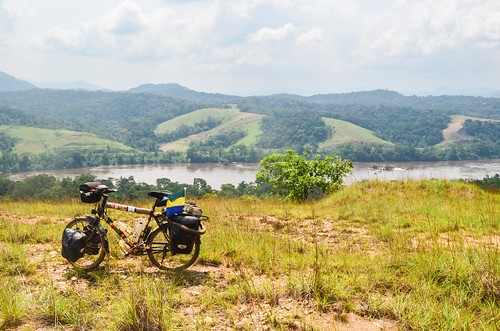

The journey on the dirt road is very hot. We must maintain a solid pace to reach Lopé town and complete those 75 kilometers in the day. It could seem easy, but times flies. From 8 am to 6 pm, we have no time to relax: cycling, taking pictures, finding or preparing food, eating, watching for animals … It’s not that easy to relax either: when we cycle, at least the wind freshens us up a little. Stopped, even in the shade, we feel we sweat more than while cycling.
My sweat is drenching my shirt. When a truck passes, it lifts up the dust, which stays in suspension for very long minutes. I get it in the eyes; my wet shirt also collects everything and I feel like a human rag. Close to 12, I really suffer from the heat. It’s uphill and there is no wind. It feels like if there is an oven open just in front of my face and someone following me with a flamethrower.
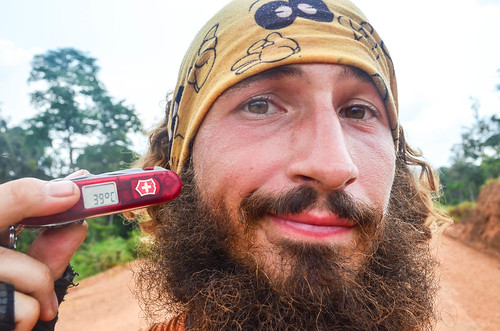

At the PK 75, we finally make it to the Ayem bridge: the national park starts!
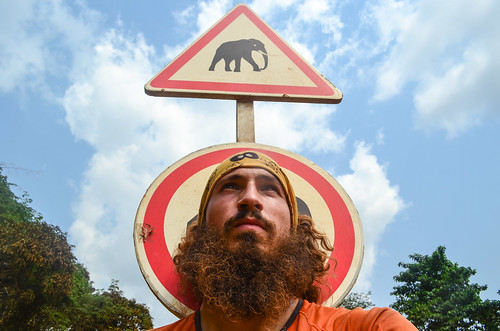
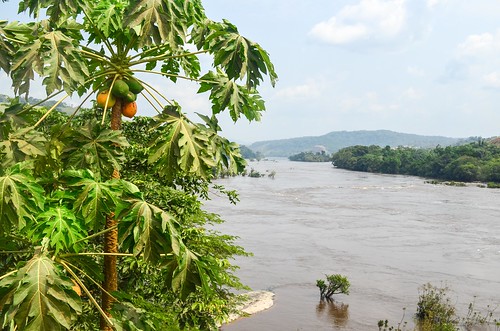
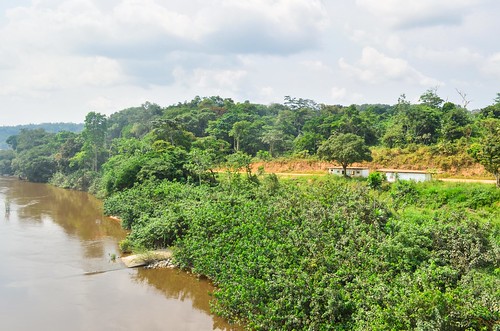
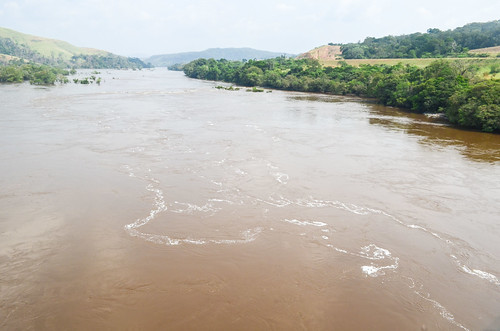
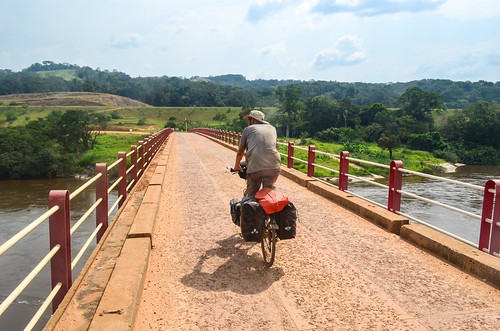
The Lopé National Park is the most well-known of Gabon. Located at the very center of the country, it was the first protected area in the country and it was added to the UNESCO heritage list in 2007.
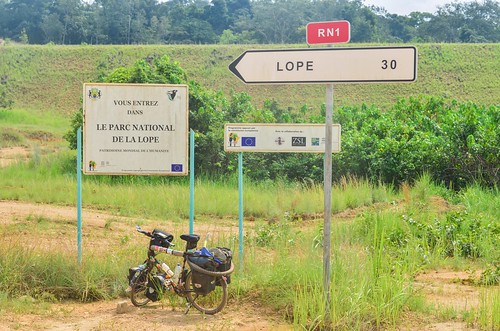
There is no entrance post or anything like this. Surprisingly, we are already on the land of the elephants and panthers. Many locals have told us we can’t cross the Lopé without encountering an animal. We also received advice on how to react in case elephants and buffaloes rest on our track. Apparently, there are no threats: panthers don’t attack humans, and big animals will eventually leave the road.
A few kilometers after the Ayem bridge is the Ayem town. It is larger than what I expected, and it is because of the railway. We are now on the same side of the Ogooué with the railway, and there is a cité SETRAG hosting the workers of the train company.
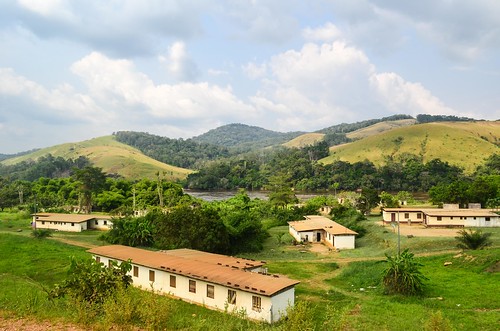
There is at least one train daily, often more. The railway is used to carry the manganese from the mine near Moanda (that we will visit later) and also the passengers between Libreville (Owendo) and Franceville. Both services are operated by Comilog, the operator of the mine.
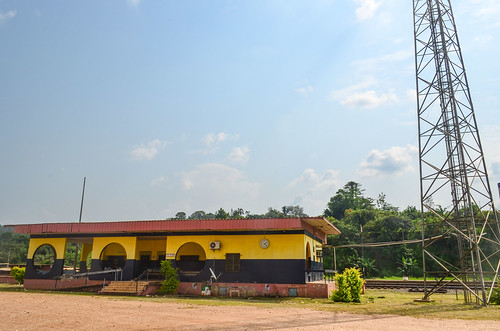
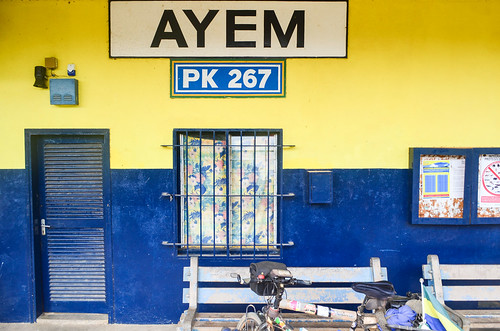
We have no time to idle, and head directly to the only place in Ayem where cold drinks are available: at the Senegalese behind the tracks. We make a lunch out of a tin can of cassoulet and continue onto Lopé town.

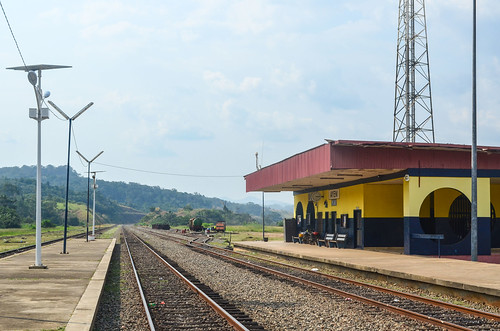
Soon after leaving Ayem, Cyril stops on the side of the dirt road.
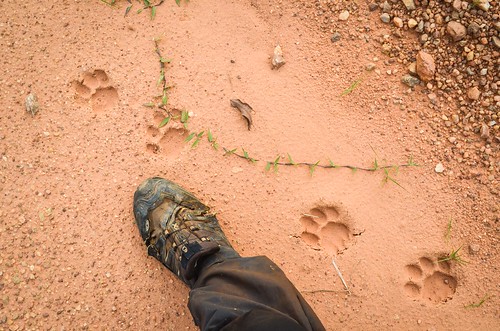
A forest ranger will confirm later that the footsteps belong to a panther.

The road is very scenic. We are now confident about reaching Lopé town before the night. We are watching for the animals, they should be around in the evening, especially considering that we don’t make any noise.
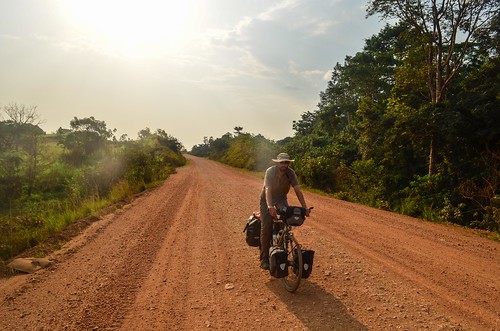
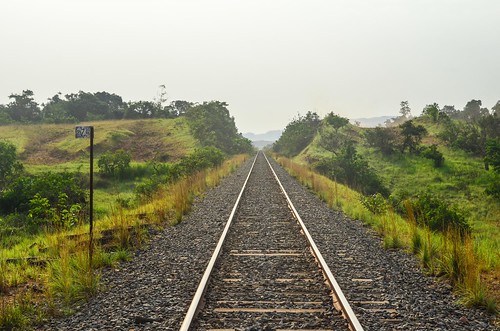

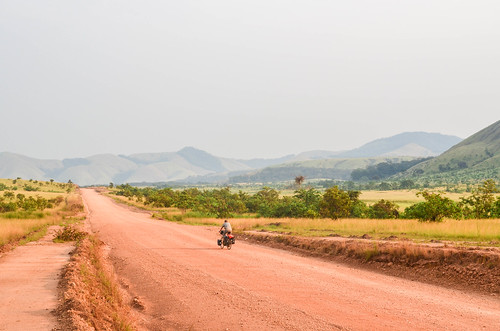
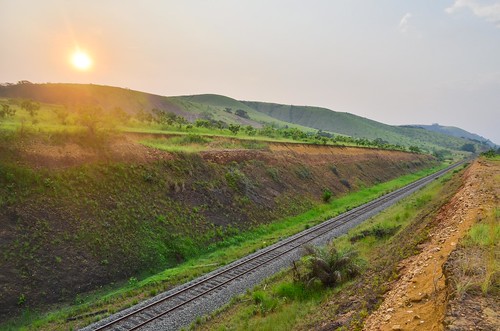
We see no elephant and we arrive in Lopé. The railway is rather well maintained. The only downside are those ubiquitous logging trucks: they repaint us with the red dust when they speed just next to us.
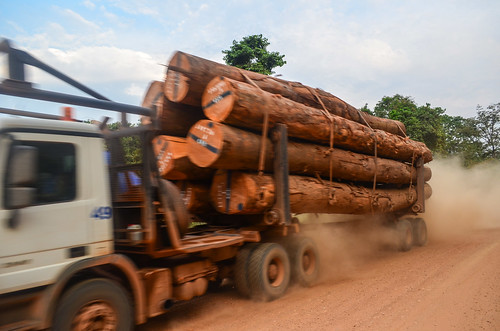
Close your eyes, close your mouth and nostrils, and wait for a minute …
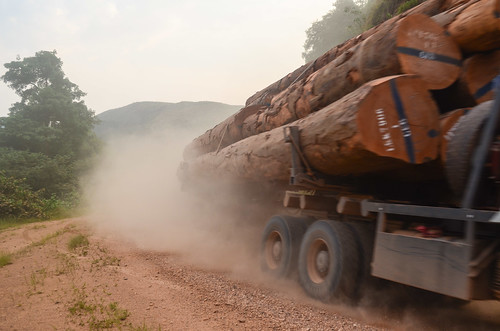
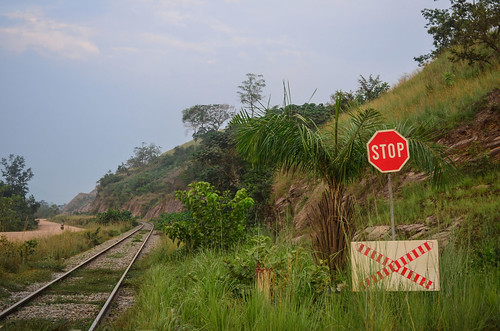
The small town of Lopé, coming from Alembé, is hidden behind the Mont Brazza. The hill bears the name of Pierre Savorgnan de Brazza, the Italian-born French explorer who traveled up the Ogooué river to “found” (there were already people there) Franceville in Gabon and Brazzaville in Congo.
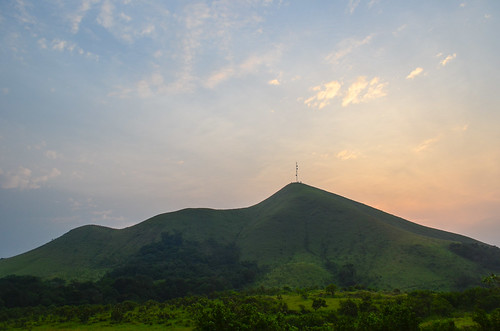
Lopé is all lit up when we reach it. There is electricity, and a relatively high number of street lights, because there is, here too, a train station. It is actually strange to see public lighting all over a village. Even in large towns, public lighting is rare.
Everyone in Lopé seem to be a foreigner. We shop at the Mauritanian and eat at the Guinean, in front of the pharmacy of a (maybe) Senegalese. Lopé is a sous-préfecture and has 500 inhabitants, it is the largest settlement of the area.

Cyril had the contact of the manager of the health center. We have trouble to find him, and the generators break down in the evening: the city is abandoned to the darkness. For such a small place, the presence of the national park gave growth to accommodation to suit every budget: the nice Lopé hotel (100’00 CFA, 150 € / night) for the proper tourists visiting the national park, the hotel for cheap tourists or rich locals (30’000 CFA), the hotel de passage for locals (5000 CFA) and the hotel with sexy posters near the train station (9000 CFA).
We finally find Brice and we can sleep at the health center.
I spend the next day with the laundry and the bike. I had another puncture on my rear wheel, and the base of the valve is leaking as well. It’s a miracle it held the air for a whole day. At noon time, it’s already too hot outside. When I walk in town, I am burning. There is no one outside. The dusty track running through Lopé and the deserted houses, the Mauritanians lying by their boutiques and the silent sun make me feel in the Far West. The few pedestrians use an umbrella (many of them are promotional umbrellas from the last elections) as a sunshade. But the Toyota is the preferred vehicle.
Like the kids, we go and jump in the river. It is the only thing to do. As well as a rare opportunity to wash my hair.
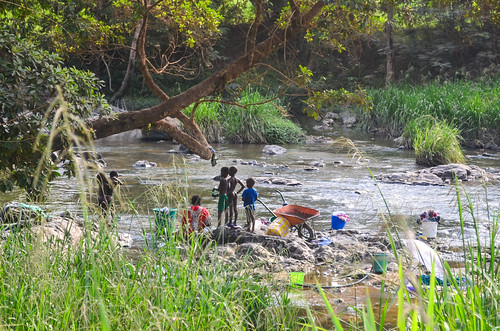
Despite hearing many times we would definitely encounter elephants here, we didn’t see any yet. I spot a small crocodile or a monitor running. There are elephants footsteps as well, just behind a new house compound. It is the end of mango season, hence elephants have been visiting the villages. They also appreciate very much kassava, banana and peanut leaves, which is what is usually grown.
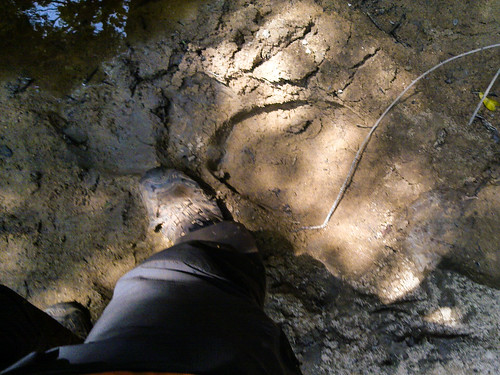
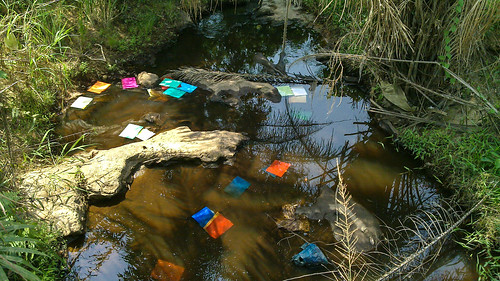
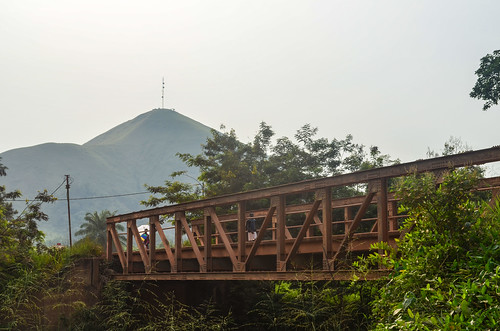
As Cyril managed to find the forest ranger of whom we were earlier given the contact details, we embark for a short evening jeep safari so as to finally see those elephants. We drive 30 km on the dirt roads of the park. The ranger says the bird we have been hearing often those last days is the Great Blue Touraco. It makes a very loud and characteristic sound that I mistook for a monkey at first. Another one of the local birds is the casqued hornbill.
The national park only attracts 3000 visitors per year. In comparison, two of the most popular parks in Africa, Kruger (South Africa) and Serengeti (Tanzania) receive respectively 950’000 and 350’000 visitors yearly.
We only see buffaloes, sadly we are unlucky with the elephants. But we have another full day of cycling in the Lopé tomorrow.
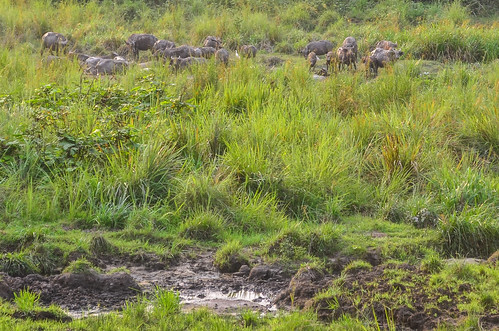
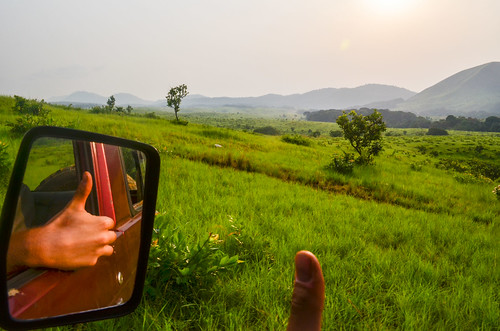

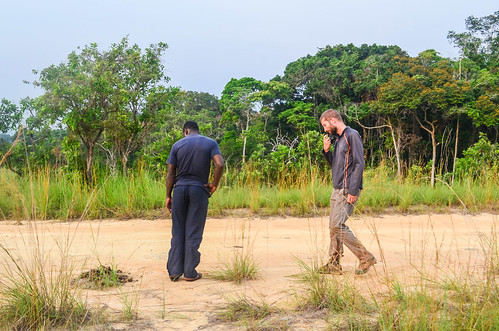
The park is also protected because of its civilization history, with remains of rock art and past techniques.

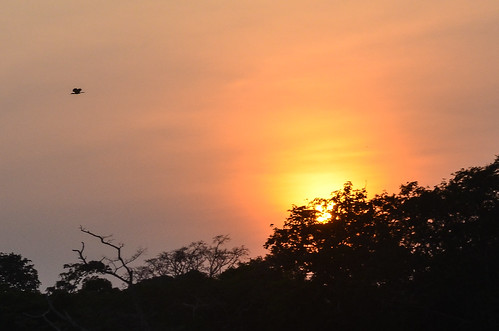

Lopé is another gastronomically depressing place to be. The only foods are chicken and rice, selling for around 2000 CFA, easily twice more than what I am used to. And the bread sold here is from Libreville! I can’t believe that bread is transported from 300 km away to be sold here. This shows how hard it is to get any food in Gabon. How come no one bakes bread in the town? There are however smaller breads available, delicious, probably made by a Mauritanian, but in small quantities.
The boiled egg for breakfast costs 250 in Lopé. It was at most 100 CFA in West Africa. I am thinking of those prices as if I was coming from Dakar or Cotonou. It seems life in Central Africa is significantly more expensive and food much worse.
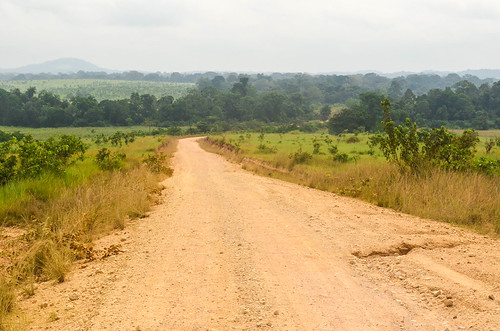
The dusty road tasting like corrugated iron leads us further east. The heat is still terrible, and our water bottles are empty after only 10 km. We must refill at the water pump of Kazamabika, another small village with a Far West touch.

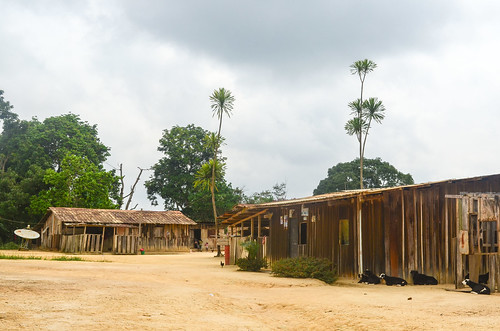
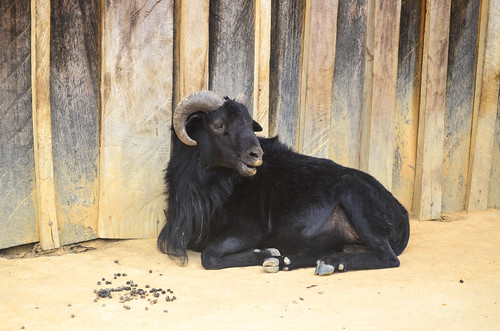
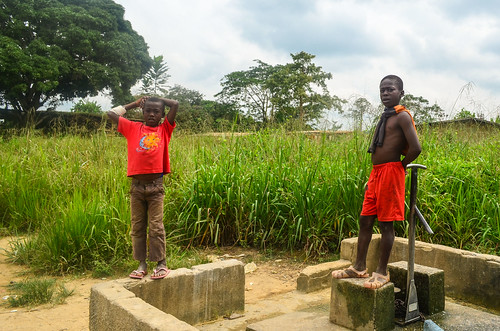
A few kilometers further, we stop again to investigate the jungle and find the monkeys. The tree branches are moving like if there is something on them. We end up snapping the road, which is always nice around here. A good quality dirt road is the best.

The place to look at is actually the floor. Our bicycles are parked right on elephant footsteps.

Attacked by the flies and bees that prevent us to stop more than a minute at the same spot, Cyril is already gone. I venture further in the bush following the footsteps.
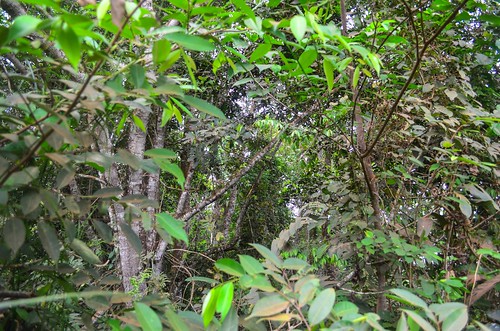

The path leads to savanna behind the trees. I wonder what I am going to find.

The path, maybe made by elephants, leads me to a pond where three buffaloes rest. Buffaloes are peaceful but all the locals will say they can charge humans if they feel threatened. I get closer to the pond and they start running, fortunately, in the opposite direction.

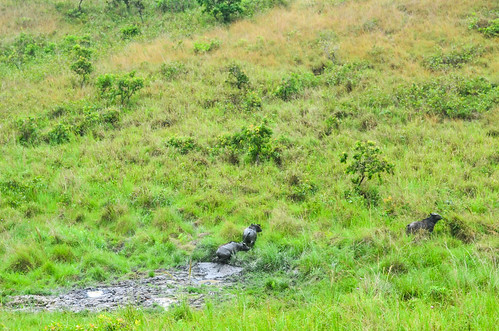
When I return to the main road, I spot even more monkeys, too small and too quick to hide. There are many traces of elephants around them, where a river passes.
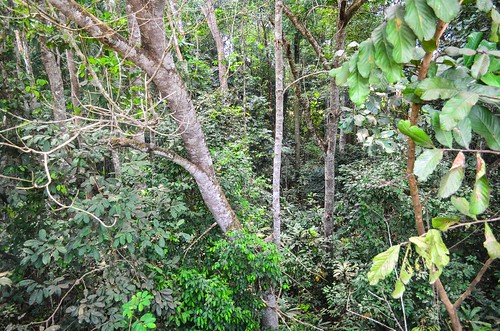
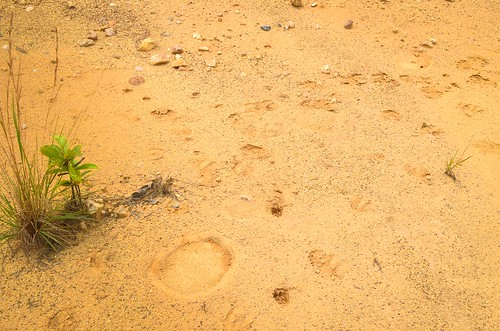
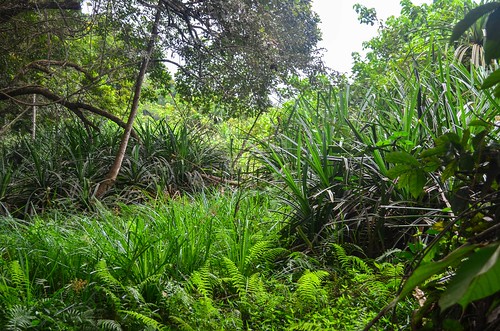
Stopped at the next village, Cyril tells me that the elephants apparently visited the place yesterday evening to eat mangoes. We just missed them. They come to the villages in the evening and return to the bush before the morning.

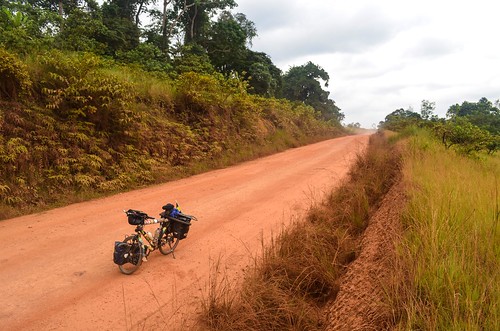
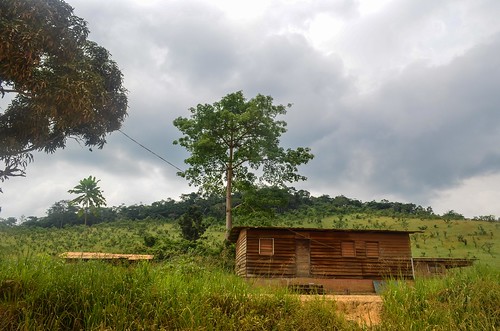

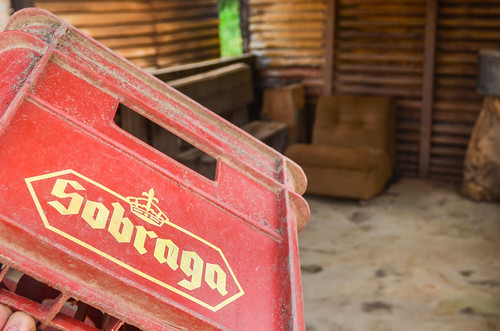
When in Togo, I had already written about the monopoly of the Castel group, via local companies bearing almost the same name and selling the same drinks. First spotted in Senegal, they bottle beers and soft drinks all over West Africa. Sobraga is also one of them.
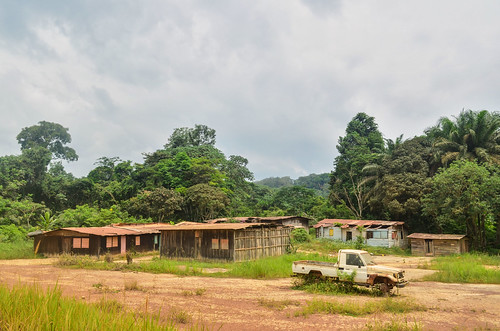
It is quite hard to find a spot to rest without being annoyed by the bees. We finally stop at a river for a lunch and a quick bath.

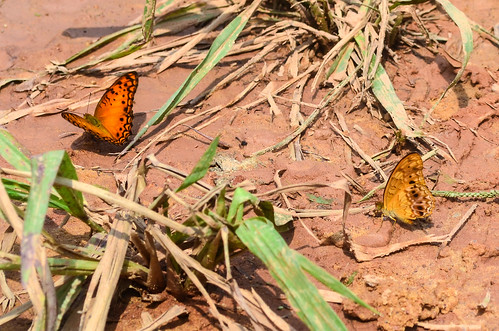

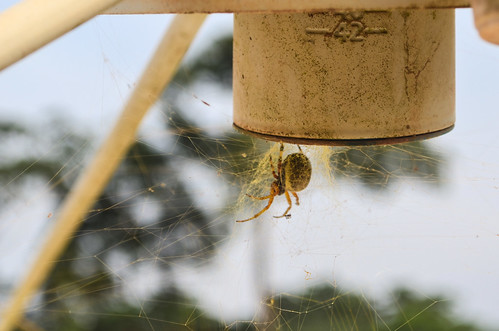
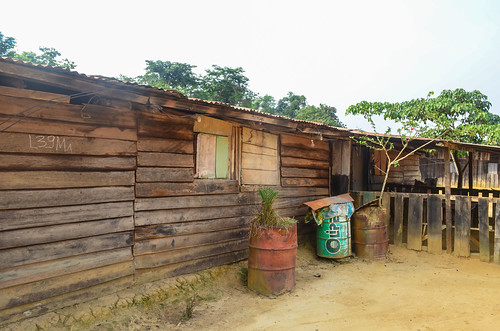
Like in Ayem, the Ogooué river marks the boundary of the park and we exit la Lopé on a steel structure. We have not seen the elephants yet …
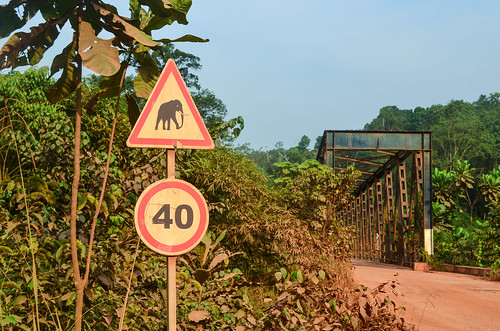

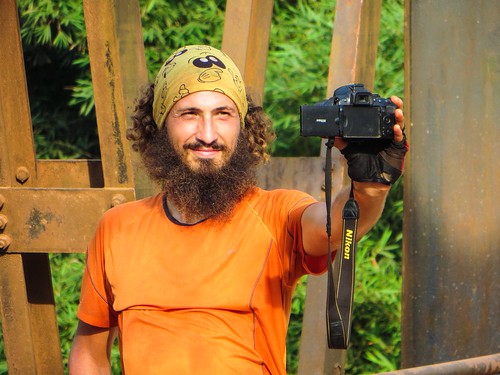
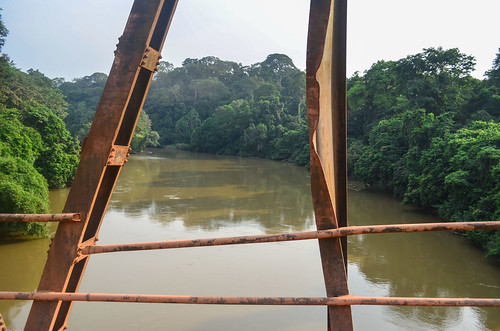
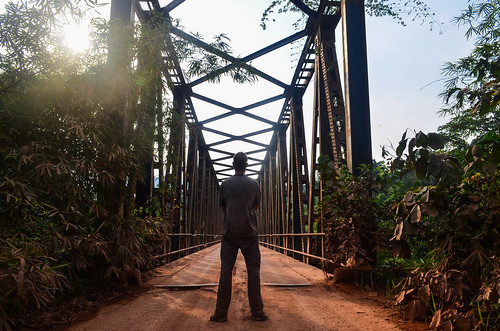
The first village after the exit bridge is Ramba, the Pygmy village. I was excited to visit an authentic Pygmy village, but I quickly disillusioned. We are “welcomed” by the rough people at the bar by the main road. Before saying that we stopped here to fetch water, we are asked to buy them alcohol, and informed that taking pictures is forbidden (unless we pay) and that there is a waterfall behind the village (which also costs money to see).
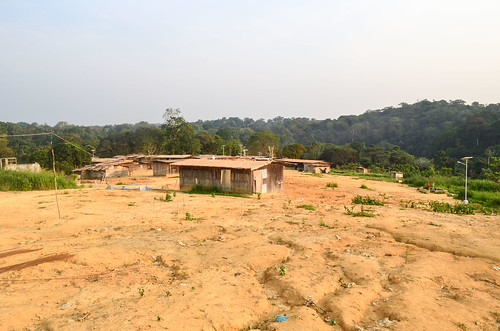
We barely saw any tourist in Gabon. There were just those Western and Chinese tourists staying at the posh hotel in Lopé, but we didn’t even see them on the few streets of the town. I don’t like people who think that the Whites are here just to give free beers and free money. Hmmm … that would make too many people, let me rephrase: I don’t like people who openly requests beers and money as soon as Whites show up. Ramba is not even a tourist site, it is just small village like many others, known to be inhabited by settled Pygmies. It has one thing extra: brand new solar lamps. Pygmies live in Central Africa (distribution map), mainly in the rainforests.
I understand that travelers who want to enjoy their holidays can’t find many places to go to in Africa. Generally speaking, remote places have the kindest people, but are hard to reach and have “nothing to see”. Tourist sites are often badly organized and the people are everything but nice. Then, remain only the expensive hassle-free packages where operators take visitors to remote places.
We just want to have a cold coke, and maybe stay for the night if we get a good feeling. However, the only cold drinks available are beers and there is no good feeling anyway. We just fill our water bottles with the disgusting borehole water (that we throw away soon after, maybe the two deformed children seen there are water victims).
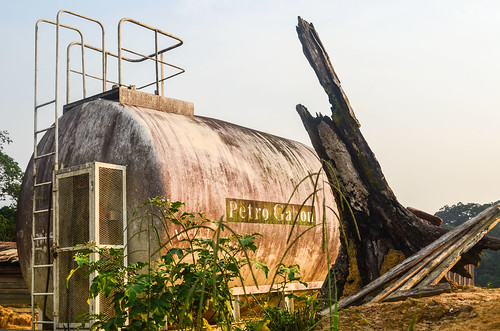
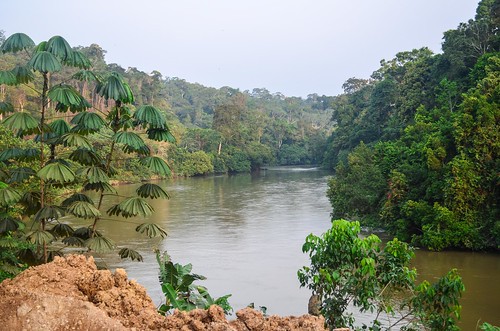
We cannot cycle fast on this bad road but we manage to reach Carrefour Leroy, the “big village” we were told about. At the crossroads, we ask where exactly the village is. “It is over there, you just passed it“. The village is made of 3 houses and 2 inhabitants. But it is extremely well supplied (per capita) : 1 water pump and 2 brand new solar lamps.
Carrefour Leroy is relatively well known in the region because it is where the Chinese will end the new road, starting from Mikouyi. By the way, there is a group of 6 Congolese currently building the future Chinese camp, aimed at hosting the Sinohydro employees. While we enquire about camping, the head of the construction team offers a room in one of the just-finished wooden buildings. It is nothing more than a concrete slab with wooden walls, but it is perfect for the night. We shower at the pump, naked in the jungle, under the eight million stars in the sky.
The workers make a bonfire from the large amount of scrap wood. Three quarters of Gabon’s land surface are covered with forests, hence there is no shortage of good timber. The boss tells us that in order to buy food (rice and chicken) for his team, he must travel 64 km westwards or 57 km eastwards until the first shop. We know that … we just made 64 km today and we can confirm there is nothing on the way (but rough Pygmies with beers). He says there are three villages with shops along our next 100 km. Logistically, Gabon really feels like the Sahara desert: there is no food available for hundred of kilometers along the road called N1!





Leave a Reply